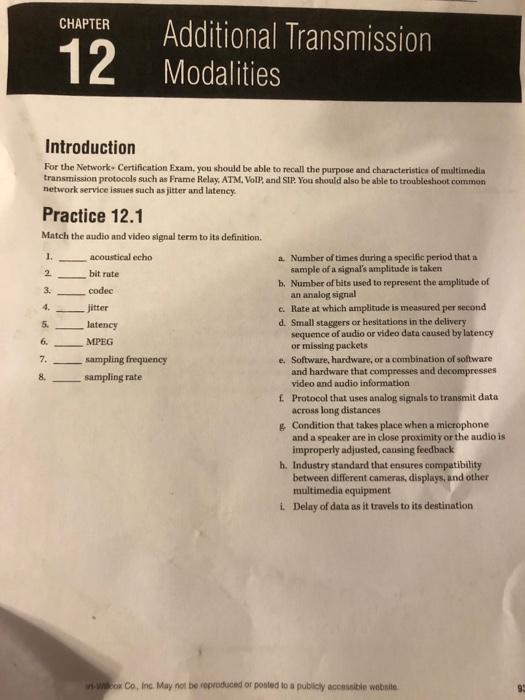CHAPTER Additional Transmission 12 Modalities 4. Introduction For the NetworkCertification Exam, you should be able to recall the purpose and characteristics of multimedia transmission protocols such as Frame Relay, ATM, VOIP, and SIP. You should also be alsle to troubleshoot common network service issues such as jitter and latency. Practice 12.1 Match the audio and video signal term to its definition 1. acoustical echo a. Number of times during a specific period that a 2 bit rate sample of a signal's amplitude is taken b. Number of bits used to represent the amplitude of 3. codec an analog signal jitter c. Rate at which amplitude is measured per second 5. latency d. Small staggers or hesitations in the delivery 6. sequence of audio or video data caused by latency MPEG or missing packets sampling frequency e. Software, hardware, or a combination of software and hardware that compresses and decompresses 8. sampling rate video and audio information Protocol that uses analog signals to transmit data across long distances & Condition that takes place when a microphone and a speaker are in close proximity or the audio is improperly adjusted, causing feedback h. Industry standard that ensures compatibility between different cameras, displays, and other multimedia equipment i. Delay of data as it travels to its destination 7 w we cox Co. Inc. May not be reproduced or posted to a publicly accessible website 9 Practice 12.2 Match the multimedia transmission protocol to its definition 1. Asynchronous Transfer Mode (ATM) Internet telephony protocol that uses existing 2 Frame Relay TCP/IP technology and equipment and is designed for high-performance data delivery and 3. Voice over IP (VoIP) quality of service X.25 b. Packet-switching protocol that typically uses leased lines such as TI to carry data over long distances c. Protocol that uses analog signals to transmit data across long distances d. Protocol designed especially for carrying audio, video, and multimedia Practice 12.3 Identify the characteristics as belonging to Asynchronous Transfer Mode (ATM) or Valce over IP (V.ZP). Terms may be used more than once. 1. Designed for carrying audio, video, and multimedia. 2 Supports a bandwidth in excess of 2 Gbps. Can be used by mixing TCP/IP with modern telephone technologies 4. Designed to divide text and audio/video into cells of 53 bytes each. 5. Uses a series of UDP packets to send volce data across a network 6. Can be transmitted at a constant bit rate (CBR) or at a variable bit rate (VBR). 7. Relies on existing TCP/IP technology and existing TCP/IP networking equipment Gives cells carrying audio and video the highest priority so that a constant flow of the time-sensitive data can be maintained. 9. Is separate from the TCP/IP stack and uses special equipment designed for the protocol, such as switches and dedicated communication lines. 10. Is less expensive for long-distance calls when compared with existing telephone technologies. 3. 8








